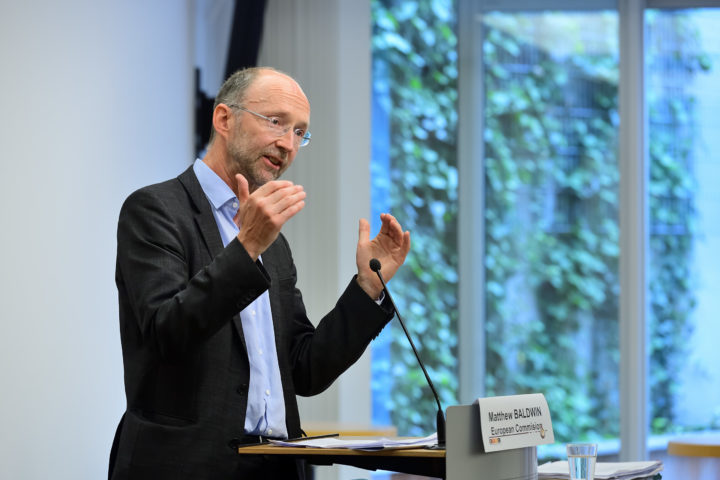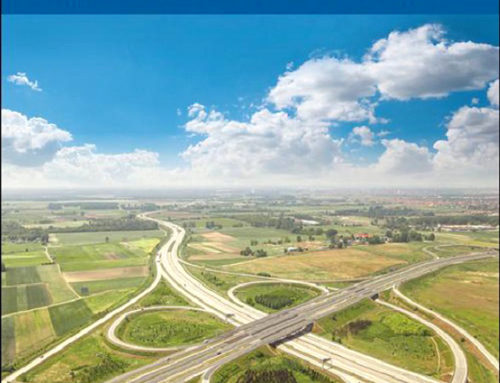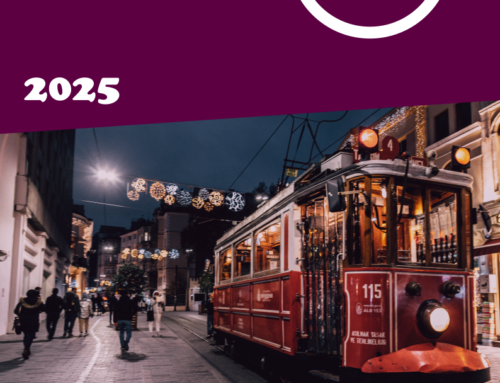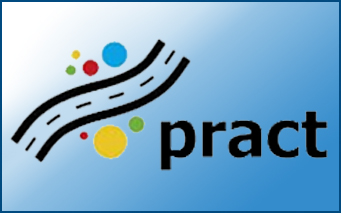
EU Transport Commissioner Violeta Bulc recently announced the appointment of Matthew Baldwin as European Coordinator for Road Safety to help drive forward the new road safety strategy as set out under the key actions in the Commission’s third Mobility Package to modernise Europe’s transport system in May 2018. The role will involve the coordination of road safety efforts with Member States, the European Parliament, cities, regions and all stakeholders in the road safety community. ![]()
![]() Matthew Baldwin gave an exclusive interview to the NTUA Road Safety Observatory:
Matthew Baldwin gave an exclusive interview to the NTUA Road Safety Observatory:
NRSO: Matthew, tell me a bit about this new role of the European Coordinator for the promotion of road safety in Europe and what will be your specific areas of focus?
MB: First, thanks for this opportunity to set out what this role is all about and how I see it as fitting into our road safety “architecture”. It stems from the European Commission’s proposals last May for a new common framework for road safety and a strategic road safety action plan for Europe. We felt we needed someone to promote and coordinate this work at the European level, to give the proposals a push with Member States, with NGOs, with industry – and with vital academic bodies such as the NTUA! Luckily for me, Commissioner Bulc asked me to do it as part of my responsibilities as Deputy Director General here at DG MOVE, and to focus in particular on how we can deliver the results, how we can get back on the downward curve for deaths. Your readers will probably know, but we managed to reduce deaths by more than 50% in the first 15 years of this decade, but in the last few years, this has flattened out and we are currently going to miss the targets for 2010-20.
MB: So we need, as Commissioner Bulc puts it, a paradigm shift. Connected, cooperative, automated, autonomous mobility will ultimately deliver huge benefits – but for many years to come, probably for most of the next two decades, we will need to rely on implementing the Safe System as humans will continue to make mistakes, and we need to do everything we can to stop people dying or being seriously injured by those mistakes.
MB: There’s certainly a lot going on at national, regional, city level, reflecting the diversity of road safety performance across the EU, and we certainly don’t want to try to push a top down, one size fits all, model. What we are proposing is to widen the scope beyond the classic TEN-T roads to include the next level down, the national or primary roads, and where around 40% of the deaths occur. We also want Member States to take the needs of Vulnerable Road Users systematically into account in their infrastructure planning. The other big piece of legislation where our friends in DG GROW have taken the lead would add 16 new features to EU wide vehicle safety standards, such as intelligent speed assistance, automated braking, for all EU vehicle categories and models. I can’t stress enough how important these proposals could be – our detailed assessment suggests that they could together reduce deaths by more than 10 000 over the next decade, and serious injuries by more than 60 000 – and this is on top of the thousands and thousands of lives that existing legislation has saved. That’s just an illustration – I hope your readers will have a look at our proposals and give us feedback on how we can best implement a new European Road Safety Strategy.
MB: And as to my own role, well I’m still in my first month in the new job, so I am talking to everyone about everything, but I intend to approach it with all the energy I can muster. I am still looking for new ideas, so please follow me on Twitter on @BaldwinMatthew_ and tell me what YOU think needs to be done.
NRSO: Let me ask you about another aspect of the Commission proposals – these Road Safety Key Performance Indicators – how will these work to deliver the EU road safety strategy?
MB: Good question. The need for Road Safety KPIs goes back to the targets. Once again, we are aiming to get to Vision Zero – no road deaths – by 2050. Road safety is an epidemic – and if we can eliminate other epidemics like cholera and smallpox from the EU, no reason not to do the same for road safety. Obviously, with such an ambitious goal, you need to tackle it in chunks and set intermediate targets. It sounds obvious but targets are really really important if we want to get results. Some people argue that targets are dangerous – that if we miss them, we decredibilise the ultimate goals, make people give up. I disagree – we must keep road safety in the public mind, keep our politicians focused on it, as only that way will we get the investment, the people, to work on it.
MB: That is why it is so important that we have at EU level targets to go once again for a 50% reduction target in deaths, and this time also for serious injuries. But – and this is the key point – targets on their own won’t deliver results. We need to apply what we know works, from the massive research that has been done for so many years into the cause of road deaths and injuries, and agree together with the Member States where to put our energies.
MB: And that’s where the Road Safety KPIs come in – to take different elements of the Safe System like seat belt use where we KNOW that improved performance will deliver better results and to eventually identify a subsidiary target. So I hope we will agree on KPIs for protective equipment like seat belts, for use of the safest vehicles, for safe infrastructure, for emergency care, and so on. It’s difficult work as of course the road safety landscape is not the same across Europe. Just take speed, for example, where we have very different limits in different parts of Europe, and different cultures of respect for those limits, enforcement and so on. So we would like to start simply by identifying how much respect there is for existing limits and then later try something more sophisticated that would enable us to measure, and target improvements in, safe speed that takes account of infrastructure, weather conditions and so on. But the bottom line is that we get agreed baselines, common measurement methodology, and link the indicators to the overall outcome targets. Getting the data together is hard, but really important.
NRSO: How you envisage to convince transport / mobility authorities and stakeholders to put road safety higher on their agenda?
MB: Well that’s a leading question ! it would be wrong to suggest that Member States, regions, cities, aren’t already doing their best. But it is also true that resources are so limited now in the public sector, and road safety doesn’t seem to be one of the glamorous topics ! There’s also the strange phenomonen which of course applies globally, namely that we appear to ACCEPT so many deaths – 1.3 million globally, 25,000 a year here in Europe, which of course makes us a success story, relatively speaking. So we need to “stop accepting” this, and I think Commissioner Bulc has done a great job in pushing transport ministers and others not to accept this silent killer. We wouldn’t accept anything like that number of fatalities in other forms of transport or indeed our daily lives, and we shouldn’t accept it for road safety either. Much more prosaically, I want to promote this important Safe System concept of shared responsibility, which applies at all sorts of different levels. We all share responsibility for road deaths and injuries – the road user and other road users, public authorities, the police, car companies, health care systems – and we need a very active, cooperative, holistic approach. We are certainly not into the blame game here, and while of course Member States must take responsibility for what goes on in their countries, there is so much more we can do than naming and shaming – we can learn from each other and promote best practice, such as in putting together national road safety action plans. Put simply, if we can make road safety more of a political priority, more of a collectively shared endeavour, we can develop a virtuous circle to promote change – and get us back on the downward curve of deaths and serious injuries.
MB: The other crucial thing is funding because that is a vital lever to support road safety. We will encourage the use of EU financial support from European structural and investment funds for infrastructure upgrades, for example. I am glad that there are a good number of applications in response to the Connecting Europe Facility’s latest call which expires[d] [this month] [in October] because as Slovakia for instance has shown, some cleverly deployed but even limited funds can go a long way in improving infrastructure. But what we are working towards, what we would most like to see is a flexible, one stop shop for access to different forms of EU funding, whether it is for infrastructure, training, enforcement, so watch this space !
NRSO: What is the link to sustainable mobility in your job title ?
MB: Two things. First and foremost, it is because the statistics show that Vulnerable Road Users (motorcyclists, cyclists, pedestrians) are taking a much bigger share of the casualties. I am told, for instance, that 90% of casualties in Sweden are now VRUs, i.e., those without the protection of a vehicle. We should be celebrating new forms of mobility, particularly active modes such as walkers and bikers, and it is unacceptable (to use that word again) that death and injury should be the result. So I want to work closely with cities in particular in existing forums such as CIVITAS to promote sustainable and safe mobility ! The other point of course is that connected, autonomous, driving etc is going to pose a lot of new challenges, especially in the course of the next two decades as new vehicles come onto our roads. Infrastructure performance requirements will change, eg for road signs. And very different levels of automated vehicle will have to co-exist with each other AND with fully human-driven vehicles for many years to come. As these new systems, such as Cooperative ITS which we are doing a lot to promote here in the EU, are introduced on our motorways, in our urban areas, I want to work with Member States and cities on how best to do this, and how to ensure safety is always to the forefront of decision making.
NRSO: What are your immediate plans for the promotion of the EU road safety strategy?
MB: Again, there is a lot of work going on in the Commission and across the EU, and I should stress that I am not doing all of it or planning to ! I first want to talk to all member states, focusing first perhaps on those where the problem is greatest (we have a wide divergence in death rates) and really hear from them how we can best work together on this. We have a very good established committee which I chair, called the High Level Group, made up of directors from all the Member States responsible for road safety, and I want this group really to be the steering committee for the new strategy (for example, agreeing on the new KPIs). Time is very short if we are to get the new strategy in place for the start of the next decade – I hope we can have initial agreement to what KPIs we are going to deploy by summer 2019. It is also absolutely essential that we get the revised infrastructure directive and car safety regulations agreed before the current European Parliament comes to an end in May of next year. So we will be pushing these issues hard, and also working with UNECE to make sure that we can as far as possible translate and apply globally the safe standards agreed in Europe, particularly as we start to establish standards for automated driving.
MB: Once again, it is a big honor to be asked to work on these vital questions. I want to be a useful resource for Member States, and to work effectively in partnership with them – and all other players in the field. Thanks a lot for this opportunity !

















































































































































































